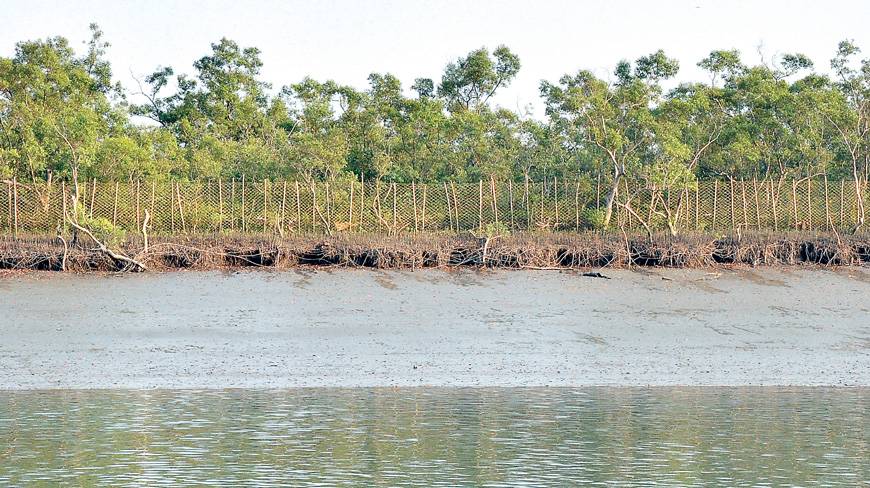India found success in stopping large-scale depletion of resources by curbing human intervention
Reducing human intervention is the cornerstone of conserving the mangrove forest Sundarbans. India has found out that providing alternative livelihood for people dependent on forest resources can be effective as well.
Authorities in West Bengal of India have found some success in deterring rampant extraction of natural resources by turning them into farmers and fishermen and promoting eco-tourism.
Ten years ago, the West Bengal government, in association with NGOs, initiated an alternative livelihood programme in a fringe village called Bali – with a population of about 37,000 – in South 24 Parganas district where a part of the Indian Sundarbans lies.
The target was to turn people into paddy farmers, fishermen, honey-collectors and eco-tourism entrepreneurs so that they did not have to depend on the forest.
They were provided with all kinds of agricultural inputs such as seeds and irrigation machinery, enabling poor farmers to grow crops in whatever little land they had. Locals only had to invest their labour.
“The Bali area is now a multi-crop zone. Earlier people used to grow only one crop – the Aman paddy,” said Anil Mistri, principal field officer of Wildlife Protection Society of India (WPSI).
“Now that they can grow several crops, they do not have to venture into the forest for a living anymore,” Anil said.
According to the World Wildlife Fund (WWF) India, only about 20% of the people in Bali go into the forest nowadays, but that too occasionally.
“Around 4.5 million people live around the Sundarbans in India. Of them, one million live in 46 fringe villages. Bali is one of them. This could be a role model for alternative livelihood practices. The villages in the Bangladesh’s part of the Sundarbans can follow suit,” said Anurag Danda, head of climate change adaptation of WWF-India.
These came to light during a three-day excursion to the Indian portion of the Sundarbans organised by the WWF with journalists of India and Bangladesh. They also had the opportunity to speak to experts, project authorities and locals.
Anurag said the success in Bali is still to be replicated in all 46 fringe villages but they hope to have similar achievements in the future.
During a field visit, this reporter met Harishadhon Sarker, 30, a resident of Bali. “The situation has changed remarkably in the area over the last 10 years. Many people have turned into crop and fish farmers from fishermen, honey collectors and extractors,” he said.
“We have already reduced indiscriminate extraction engaging people with different types of alternative livelihood options,” said Subash Chandra Acharya, former joint director of the Sundarbans Development Board of the West Bengal government.
“Strong implementation of existing laws to protect the forest has also played an important role in getting results,” he added.
Turning fish- and crab-catchers into fish-farmers has been of particular importance for the water bodies inside the forest because years of indiscriminate fishing had already led to an alarming depletion of fish variety.
“Most of the fish species are gone now. Even 20 years ago, we used to catch different types of fish. But now, there is only vetki,” said Soumen Prodhan, 35, a resident of a fringe village called Sonagaon.
This is one reason why many fishermen have been forced to become cultivators, he said.
At present, there is a ban on catching all kinds of fish and crabs except for shrimp under 500 grams.
Fencing in the forest
Fencing of the forest area with iron poles and polythene nets has significantly reduced conflict between tigers and humans living in the territory.
Suryakanta Prodhan, 40, resident of Sonagaon claimed that there had not been a single tiger invasion over the last two years. “The fencing has saved the lives of humans and also our cattle,” he said.
However, Harishadhon from the Bali village has a different explanation.
“Because of the government’s initiative to promote eco-tourism in the Sundarbans, the number of tourists has been growing. Big boats carrying tourists into the forest have been keeping the tigers away from settlements,” he told this reporter.
On this side of the border
The government of Bangladesh is yet to take any such initiative. A number of non-governmental organisations (NGOs) have been running alternative livelihood projects in the forest but on a very small scale and are still to see any significant success.
Ishtiaque Uddin Ahmed, country representative of the International Union for the Conservation of Nature (IUCN), told the Dhaka Tribune recently that Bangladesh can also introduce similar initiatives for protecting the biggest mangrove forest in the world.
Also a former chief conservator of forest in Bangladesh, he said: “Creating alternative livelihoods should be emphasised in the Bangladesh portion of the forest because this initiative has been highly effective in reducing human intervention.”
Around 4.5 million people depend on the Sundarbans for a living in India directly and indirectly. In Bangladesh, this is around 4 million.
There is, however, one major difference between the human settlements in India and Bangladesh.
In India, a large part of these 4.5 million people live in fringe villages which are close to the forest. However, in Bangladesh, there are very few human settlements inside the forest or near the forest.
Source: Dhaka Tribune










